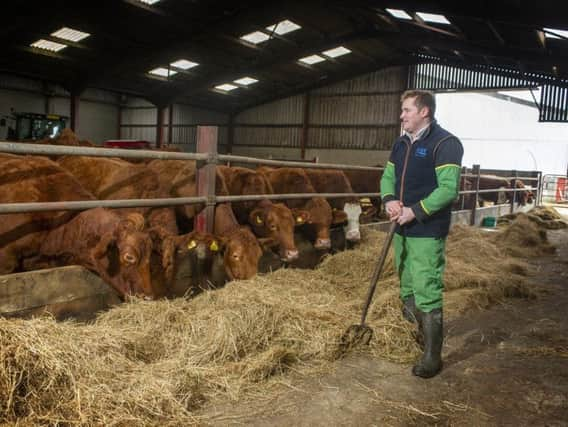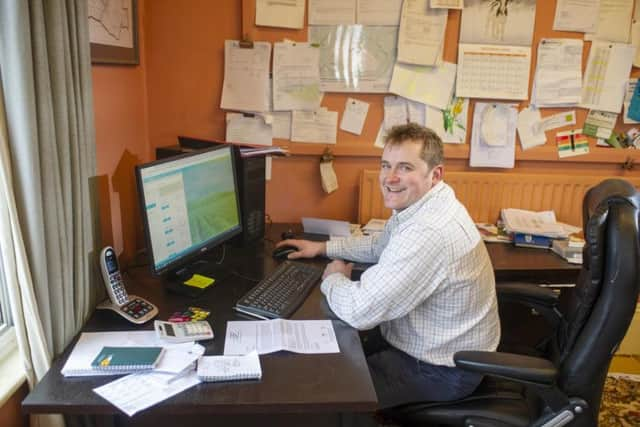Former rugby player and livestock farmer learning the ropes in arable


But the rugby player who once played against “big Maori lads who didn’t seem to like Europeans very much” when he was turning out for Riversdale RUFC on New Zealand’s south island, now confesses to playing “fat lads’ football” as a substitute for training, in preparation for his weekly appearances for Driffield’s 3rd XV.
Gary, who married Jennifer, joined his father-in-law Alec Dale on the 1,600-acre, predominantly arable Wold House Farm near Huggate four years ago with a view to a plan that sees him now taking greater responsibility for the farming operation that includes a Stabiliser herd and a soon-to-be-added bed and breakfast pigs enterprise.
Advertisement
Hide AdAdvertisement
Hide AdBenchmarking is a method in which farms are able to compare themselves against other similar farm businesses and Gary has taken the opportunity that presented itself, through the AHDB (Agricultural & Horticultural Development Board), to avail himself with as much information as he can to ensure Wold House Farm continues the work Alec has carried on since he moved here with his wife Sue in 1982 when Alec followed a similar course, in joining his father-in-law, Robert Chester.


“It was an opportunity I couldn’t really turn down, when Alec offered me the chance to come here,” says Gary. “I’m from a livestock background. My father and his brothers were in a partnership on separate farms milking 500 cows.
Billy is still flying the flag for Charolais after 50 years developing the Brampton herdWildlife artist Robert Fuller tracks the barn owls' winter fight for survival“My dad is now the only one left farming from the three, with my younger brother James at Rickle Pits Farm in Skerne where they contract rear pigs.
“We have only recently become an AHDB monitor farm after receiving an email to which I responded.
Advertisement
Hide AdAdvertisement
Hide AdWe’re still in our first year. I’m currently a livestock man on an arable farm and I thought, if Alec and Sue were keen, it would be a way of getting free advice, from people in the know, and would help with my education. At the monitor farm meetings, I’m very open about where my experience lies.
“AHDB monitor farming gives us the opportunity to be part of their Farmbench scheme that means you can compare performance against other farms. In our case that is other predominantly arable farms of a certain size and scale. Each farm is benchmarked against a small group of farmers in our local area and you are then able to also benchmark against farms nationally.
“I want to learn what the top 10 per cent are doing so that I can get us in there, if we’re not already. The only way you can do that accurately is by being part of a group like this, that then commits to the online system of Benchmark.”
Wold House Farm’s arable acreage of mainly Grade 2 or 3 land on largely free draining Wolds chalk runs to 1,300 acres with around 500 acres of winter wheats including Gleam and Graham as this year’s two main varieties and smaller acreages of Firefly and Illicit making their debut at Huggate.
Advertisement
Hide AdAdvertisement
Hide Ad“We’ve dropped Costello, which is a good variety with a high bushel weight, because it is just too late for us,” says Gary. “We have grown a lot of Grafton in the past too.
“I’m obsessed with everything being as early as it can here,” says Alec. “I’ve had years of combining in October. We’re at 700 feet, making us a high Wolds farm and we normally start our harvest a week or 10 days after everybody else.”
Winter and spring malting barley is grown with Craft having replaced Venture as the main winter malting barley, while spring barley remains as Laureate. Oilseed rape is also grown, as well as vining peas.
“The land is what they call pea sick at the moment,” says Alec. “We are halving the pea acreage and we are renting out some land for potatoes instead this year. The idea is to grow peas every 12 years on rotation rather than every six or seven.”
Advertisement
Hide AdAdvertisement
Hide Ad“Our wheat goes into the mill at Fridaythorpe just a mile away,” says Gary. “Our yields have seen some good averages. Our wheat price is currently around £150 per tonne. The best thing for us at the moment would be if the Vivergo and Ensis plants started up again.”
The Stabiliser herd runs to 80-head and has been part of the Wold House operation in the dale sides for the past four years. Alec had previously fattened big continental steers. “Nobody wants big steers now,” he says. “We are in the higher tier stewardship scheme and the Stabilisers are very good at grazing the rough grass.
“They are also very placid, an easy calving suckler herd that takes our grass and turns it into protein with good conversion rates.
“The new bed and breakfast pigs enterprise will see us with 2000 pigs on-farm in a specialist unit. We are going with Yorkshire Farmers Livestock in Malton. They particularly impressed me with their professional approach.”
Advertisement
Hide AdAdvertisement
Hide AdWhile Gary is in the early stages with AHDB over being a monitor farm, he’s upbeat about the meetings he’s attended and been part of so far.
“We had a farm walk in June. Our first winter meeting was all around soil health and there were 70 farmers at Driffield Rugby Club. We did some soil sampling on the farm and I was pleasantly surprised in the organic matter contained in our soils, considering we haven’t been putting much muck back on regularly and we haven’t really been chopping the straw.”
“We’re very lucky up here, where from this farm you can see all around to the Humber Bridge and Flamborough lighthouse,” says Alec. “We count our blessings at the moment. My father-in-law came here in 1952 when he was farming with his father-in-law and brother-in-law. I come from Thorpe Bassett near Malton where my brother Chris still farms.
“I’ve always been open and discussed costs and the type of thing that Gary is now doing with the AHDB as a monitor farm. As an ex-Driffield NFU chairman, I think we also need a strong NFU and government right now.”